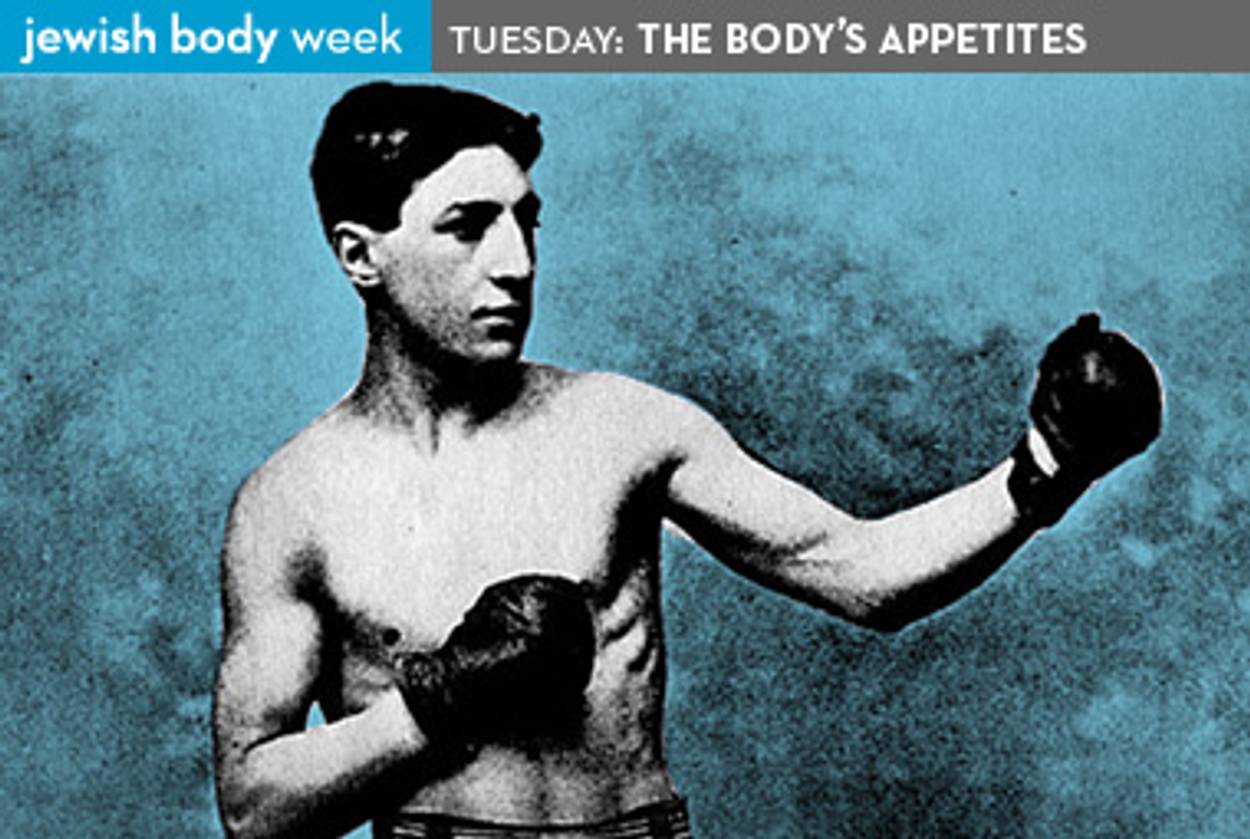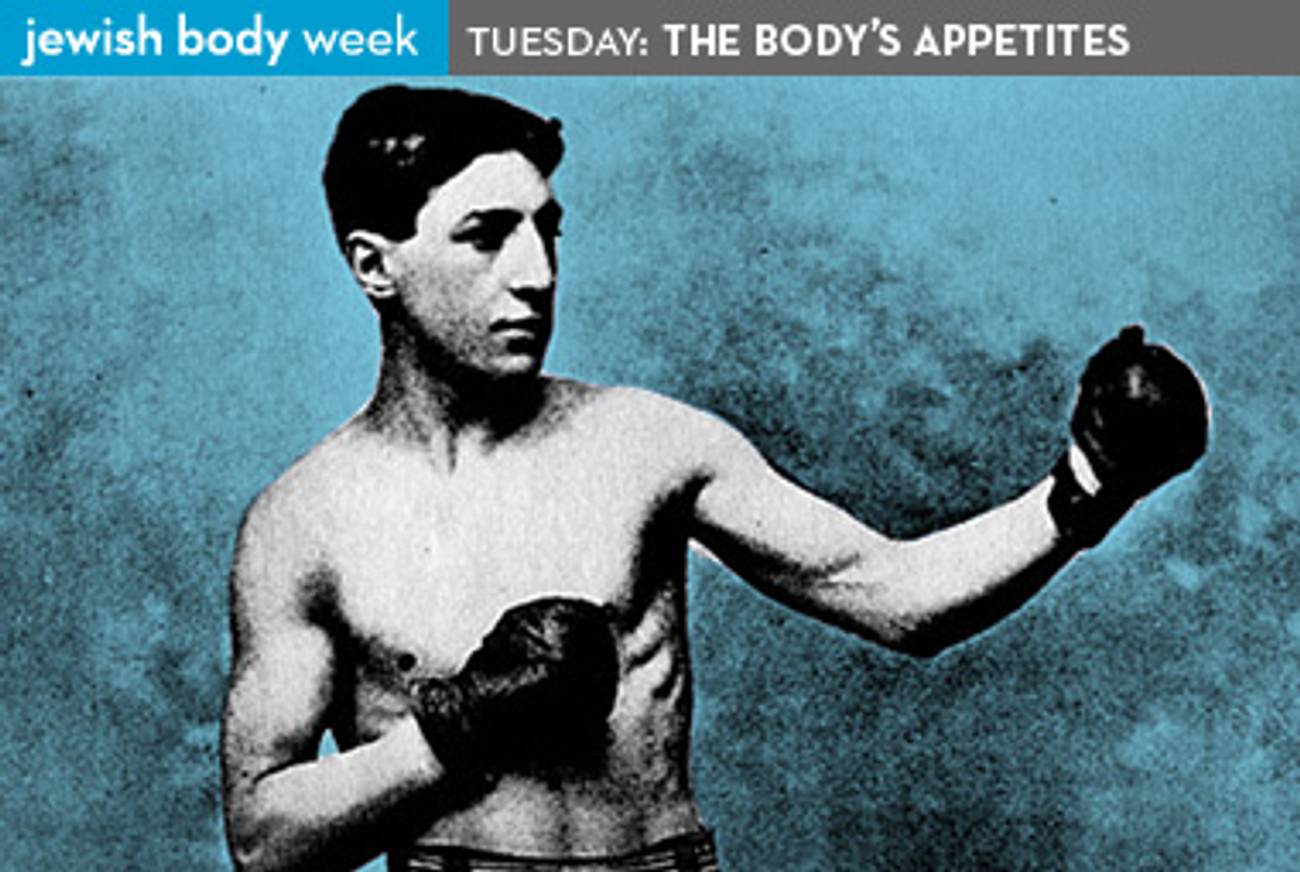Flexing Some Muscle
The boxers and strongmen who turned the image of the Jewish nebbish on its head




For many years, certain Jews—and those who dislike them—have relished an image of the Jewish body as skinny and weak, hunched-over, barely able to hold up its Jewish bobblehead, with a gargantuan brain and massive, jutting nose. This is a caricature, obviously, but one that is based on a tiny kernel of ethnic reality, a kernel that is instantly recognizable as “Jewish.”
The reality of Jewish bodies, of course, is that most of them are equally as grotesque as every other ethnic group’s bodies. Jewish bodies range from Auschwitz anorexics to jiggling, morbidly obese noshers. There are Jewish dwarves and Jews who suffer from gigantism. There are so many physical types among Jews that one might briefly consider the notion that they’re actually just like other peoples. But, Jews being Jews, such thoughts are fleeting. Stereotypes die hard. Jokes about the paucity of Jewish athletes still abound, forcing Jews who hope to counter such stereotypes to create odd publications such as encyclopedias of Jews in sports and other books and pamphlets designed to salve the wounds of a people allegedly doomed to physical ineptitude.
The concept of the Jewish nebbish, for instance, might seem like the creation of anti-Semites, but it has also long been abetted by Jews as well, who played down Jews’ physical accomplishments. In reality, while their intellectual tradition decries it, Jews have always been involved in athletics. But most of those who keep the Jewish historical record books—shameless brainiacs that they are—choose to edit athletes out of the picture. Jews were circus performers, too, from the Roman era through the Middle Ages and up to the modern period. But, once again, the people who wrote Jewish texts weren’t interested in such activities, except to try and ban Jews from participating, so they refused to document the reality of Jewish participation. Bit and pieces of evidence crop up in a variety of places. For example, interspersed in published 17th- and 18th-century lists of the few thousands of merchants who attended the months-long mercantile fairs in Leipzig—the only period in which Jews were permitted in the city—are more than 100 Jewish performers, among them acrobats, athletes, magicians, musicians, some with trained animal acts.
By the late 19th and early 20th centuries, Jewish involvement in athletics began to grow as a result of both urbanization and embourgeoisement. Moreover, Jewish political movements began to co-opt athletics as a way to engage the youth—a clever way of tricking Jewish kids into supporting political parties.
Successful Jews athletes were far more popular than politically and culturally engaged Jews of the same period. In their time, people like the boxer Benny Leonard and the circus strongman Zishe Breitbart were far better known and more beloved by Jews than a jurist like Louis Brandeis or a thinker like Mordecai Kaplan. In 1925, the Yiddish daily Der nayer varhay noted, “When Einstein visited America, thousands of people knew about it. But (Jewish boxer) Benny Leonard is known by millions.” And it is also of no small significance that such activity boosted the confidence of a socially and politically disenfranchised people. But historians and communal leaders pretend that athletics never mattered to Jews and retroactively turn the intellectual celebrities into bigger stars.
The bodies of athletes have been of interest to viewers for millennia. As Jews entered the mainstream, the strong and beautiful among them also became interesting, not necessarily because they were Jews, but because they were hot. Superior athleticism also played a major role. On the other hand, to Jewish spectators, it was simply a trifecta of “hot, Jewish, athlete” that served as a modern antidote to “crusty, bearded, rabbinic.”
Eddy Portnoy, a contributing editor for Tablet Magazine, is the Academic Advisor and Exhibitions Curator at the YIVO Institute for Jewish Research. He is also the author of Bad Rabbi and Other Strange but True Stories from the Yiddish Press.
Eddy Portnoy is academic adviser and director of exhibitions at the YIVO Institute for Jewish Research, as well as the author of Bad Rabbi and Other Strange but True Stories from the Yiddish Press (Stanford University Press 2017).